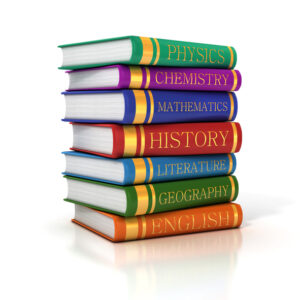Your Guide to High School Subjects – The Core Subjects and Electives That Make Up a Standard High School Curriculum
By Brian Miller, Secondary Principal
 Teachers become teachers because they have a strong sense of purpose. Teachers want to help kids and impact the world, and it almost always comes from a really positive experience they had back in school.
Teachers become teachers because they have a strong sense of purpose. Teachers want to help kids and impact the world, and it almost always comes from a really positive experience they had back in school.
Is this starting to sound like you?
Maybe you really loved the experience of all that discovery and learning that came from your high school science class and you want to be part of all that magic again… Maybe you had a high school English teacher who changed your life by showing a new way of seeing and understanding your own experiences through literature.
The curriculum you teach is the roadmap for the year, providing clarity and direction for what to teach and when to teach it. It’s also the bedrock for state standardized tests, and is generally built around the material that is considered essential for college admission and success.
Quality teachers understand that influencing kids and impacting the world is why they teach… while making use of a differentiated, student-centered pedagogy is how they teach.
As the final piece of the puzzle, the curriculum that’s provided to you by school leadership and your district is the brass tacks of what you teach.
What is The High School Curriculum? – A Breakdown of Standard High School Courses, Core Subjects and Electives
In simplest terms, high school curriculum is the knowledge and skills that students are expected to learn as they progress through the four years of high school. It is the content we teach them, and the framework of scholastic discipline and information that a school or school district deems necessary for student learning within a given year. It is the objectives, and it is the guiding force for every teacher.
At the high school level, curriculum is divided up into two groups of classes – Core subjects and elective classes.
- Core subjects are the ones that every student in the United States is required to take in order to obtain their general high school diploma. Core subjects – sometimes known and general education courses – are a foundational part of the curriculum.
- Elective classes are the extra classes. They are still required for graduation but allow students some freedom to pick and choose based on person interests – classes such as yearbook, journalism, weight training, and a hundred others.
Every subject taught within the school is expected to take students through a certain number of knowledge and skills sets within a given year. And the foundation for determining what knowledge and skills are most essential are defined by each state’s academic standards.
State academic standards are primarily concerned with what public school students are expected to learn in core subjects like reading, science, and math, but often cross over into other subjects, including health and PE. They are set by the state, not the federal government, and are assessed at the beginning and end of each academic year as a measurement of student growth.
If you are recently hired or are looking to enter the world of teaching and are curious about what you will be expected to teach, looking into your state’s teaching standards is the best place to start. Especially if you are interested in teaching one of the 5 core subjects.
What Are the 5 Core Subjects in a High School Curriculum?
 The five core subjects for every high school student will include English language arts, math, science, and social studies with the fifth core class alternating between health/PE and a foreign language course. Core subjects are guided by a strong sequential curriculum that is tied to the state and national tests, ensuring there are no gaps in learning between each grade level and that every student will have the required knowledge and skills needed for university by the time they graduate high school.
The five core subjects for every high school student will include English language arts, math, science, and social studies with the fifth core class alternating between health/PE and a foreign language course. Core subjects are guided by a strong sequential curriculum that is tied to the state and national tests, ensuring there are no gaps in learning between each grade level and that every student will have the required knowledge and skills needed for university by the time they graduate high school.
What is core curriculum in high school?
The core curriculum then, will always include the five core subjects of English, math, science, history, and foreign language or health/phys ed, though there may be some different emphasis in particular areas of those subjects depending on the state and district.
You will also almost always find courses in basic computer literacy counted among the standard modern high school curriculum. But even when required for graduation, those types of classes aren’t typically counted among the core courses – not yet, anyway.
Ultimately, the answer to the question, “what is core curriculum in high school?”, is one that is both simple and fluid. Although there can be some minor differences from state to state and even school to school on the entirety of the school curriculum, there are some hard and fast components that can be found in any standard U.S. high school curriculum:
- English: Four years – American and World Literature, literary periods, poetry, research, and writing
- Math: Four years – this often includes algebra, geometry, and trigonometry
- Science: Three classes – this often involves biology, chemistry and physics
- History: Three classes – U.S. history, world history and civics or government
- Foreign Language: Two years (sometimes optional, depending on the state) – dependent on demand and what schools can provide.
- Physical Education/Health: Two years – this can often be replaced with after-school activities, but those substitutions will need to be approved by the state or district
- Computers:Two classes – typing, Office programs and even web design courses are standard in many states and districts now, so it’s not unreasonable to expect some computer classes to work their into core curriculum status in many more states in the coming years.
As technology has become an inseparable part of our daily lives, basic computer literacy classes are becoming less necessary since most kids are already way ahead of the game in that department. But classes in coding, computer programming, and software development are likely to become as essential as math and reading in the coming years, and it’s expected that high school curriculum will begin to reflect that.
What Other High School Subjects are Found in the Typical Curriculum?
 At some schools, the core courses include arts, computer science, health, physical education, and world languages. And at any school that doesn’t make these kinds of classes part of the core curriculum, they are most certainly still up for grabs as part of the elective offerings. This is largely because universities require them, so the options need to be available for college-bound students.
At some schools, the core courses include arts, computer science, health, physical education, and world languages. And at any school that doesn’t make these kinds of classes part of the core curriculum, they are most certainly still up for grabs as part of the elective offerings. This is largely because universities require them, so the options need to be available for college-bound students.
Outside of the core classes, most schools will offer an array of other electives that are designed to meet the many needs and interests of students around the country preparing themselves to be job ready in the 21st century.
In addition to the traditional subjects and emerging technology courses that are part of the standard high school curriculum in most states, schools will do their best to offer dual-credit and AP courses. These classes not only provide more challenging classes and an array of experiences for students, they provide students an opportunity to actually earn college credits while still in high school, reducing the number of years spent in college and saving a great deal of time and money in the process.
Also, schools and school districts have recently started to include an emphasis on implementing soft skills, digital citizenship, and social and emotional health into their curriculum, going well beyond the norms of traditional high school subjects.
Currently, these standards are not tied to any state assessment, but don’t be surprised if that changes in the near future. Social, emotional, and behavioral learning is starting to gain traction. If your state doesn’t require it, more than likely your school district will.
Want to be a great teacher who maximizes you students’ success? Get to know your curriculum. There is no better place to start.
